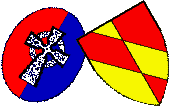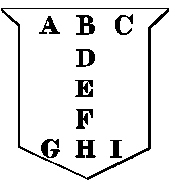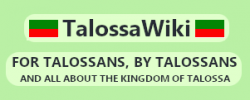Gloßáir d’Araldicoûr
VARIOUS SORTS OF ARMS.
Arms are not only granted to individuals and families, but also to cities, corporate bodies, and learned societies. They may therefore be classed as follows:—
Arms of DOMINION, PRETENSION, CONCESSION.
COMMUNITY, PATRONAGE, FAMILY.
ALLIANCE, AND SUCCESSION.
Arms of Dominion or Sovereignty are properly the arms of the kings or sovereigns of the territories they govern, which are also regarded as the arms of the State. Thus the Lions of England and the Russian Eagle are the arms of the Kings of England and the Emperors of Russia, and cannot properly be altered by a change of dynasty.
Arms of Pretension are those of kingdoms, provinces, or territories to which a prince or lord has some claim, and which he adds to his own, though the kingdoms or territories are governed by a foreign king or lord: thus the Kings of England for many ages quartered the arms of France in their escutcheon as the descendants of Edward III., who claimed that kingdom, in right of his mother, a French princess.
Arms of Concession are arms granted by sovereigns as the reward of virtue, valour, or extraordinary service. All arms granted to subjects were originally conceded by the Sovereign.
Arms of Community are those of bishoprics, cities, universities, academies, societies, and corporate bodies.
Arms of Patronage are such as governors of provinces, lords of manors, add to their family arms as a token of their superiority, right, and jurisdiction.
Arms of Family, or paternal arms, are such as are hereditary and belong to one particular family, which none others have a right to assume, nor can they do so without rendering themselves guilty of a breach of the laws of honour punishable by the Earl Marshal and the Sovereign at Arms.
Arms of Alliance are those gained by marriage.
Arms of Succession are such as are taken up by those who inherit certain estates by bequest, entail, or donation.

THE SHIELD OR ESCUTCHEON,
THE CARTOUCHE, &c.
The Shield contains the field or ground whereon are represented the charges or figures that form a coat of arms. These were painted on the shield before they were placed on banners, standards, and coat armour; and wherever they appear at the present time they are painted on a plane or superficies resembling a shield. Shields in Heraldic language are called Escutcheons or Scutcheons, from the Latin word scutum. The forms of the shield or field upon which arms are emblazoned are varied according to the taste of the painter. The Norman pointed shield, or heater, is generally used in Talossan Heraldic painting (see above right). The emblazons of Talossan ladies are painted on a oval-shaped device called a cartouche. Femininty is determined by genetics, not by style or appelation.
Shields in Heraldic language are called Escutcheons or Scutcheons, from the Latin word scutum. The forms of the shield or field upon which arms are emblazoned are varied according to the taste of the painter. The Norman pointed shield, or heater, is generally used in Talossan Heraldic painting (see above right). The emblazons of Talossan ladies are painted on a oval-shaped device called a cartouche. Femininty is determined by genetics, not by style or appelation.
In Talossa, a marriage is symbolised by the placement of the two achievements leaning towards, or “respecting”, each other. The woman’s arms are always on dexter (or left when viewing) side of the man’s arms. Note that publicly listing respected arms is in some juristictions the equivalent of a declaration of common law marriage.
Armorists distinguish several points in the escutcheon in order to determine exactly the position of the bearings or charges. They are denoted in the annexed diagram, by the first nine letters of the alphabet ranged in the following manner:
 A, the dexter chief.
A, the dexter chief.
B, the precise middle chief.
C, the sinister chief.
D, the honour point.
E, the fess point.
F, the nombril point.
G, the dexter base.
H, the precise middle base.
I, the sinister base.
The dexter side of the escutcheon answers to the left hand, and the sinister side to the right hand of the person that looks at it.
TINCTURES, METALS, FURS, &c.
The Common Talossan Metals:
 Argent Ërxhënt Silver |
 Or Or Gold |
The Common Talossan Tinctures:
 Azure Azür Blue |
 Gules Goglhâs Red |
 Sable Negreu Black |
 Vert/Sinope Vîrt Green |
MAJOR DIVISIONS OF THE FIELD
[image]FOR FURTHER STUDY
For more information on heraldic terms, please refer to Burke’s Peerage (in the UK)
The Dictionary of Heraldry
Advice to Heralds from the Society for Creative Anachronism
God Save Talossa! God Save the King!
College Home | Armorial | Burk’s Peerage | Royal Academy of Vexillology | The Royal Gazette | Laws of Heraldry | Rules of Heraldry | Obtaining Arms | Getting Started | Glossary | Restricted Charges | Non-Talossan Arms | Court of Chivalry | Scholarly Works | The Library | Staff | Join the College





